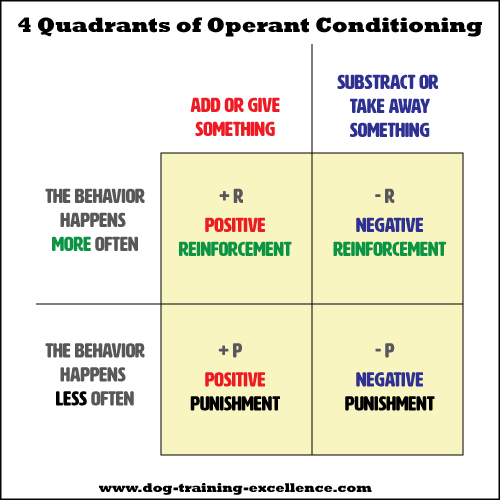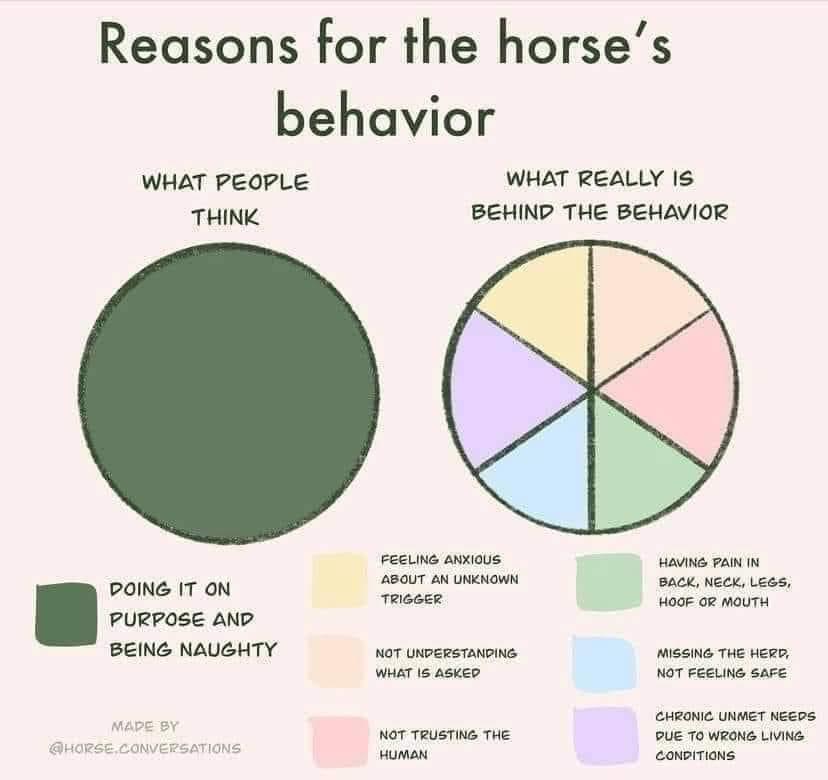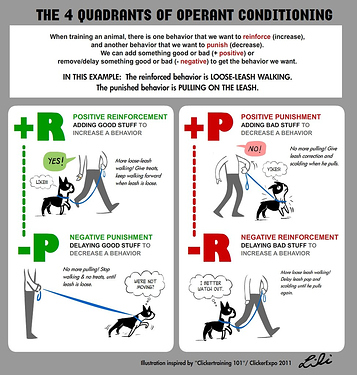I begin riding all the horses bareback. And with the mustangs, just like the woman in the video…without anything on their heads. They learn to walk up to the mounting block and stand still while i mount. And stay there. If it’s the first or second time i climb up and they start moving i will just slide off. I need to trust them as much as they need to trust me. It’s a two-way street. Some just stay there, but most will walk off and for a few days we just do that…walk up, stand-stay, i mount, they walk on and i slide off and try again. Until they stay there until i ask them to walk on (by leaning forward and asking them “walk on” …a word they already learned from halter-training) i do not remain on them. Also, like the woman in the video, i will give them good scritches on their neck…probably for about 5 times longer than she does though.
Don’t know quadrants per se, but the concept of taking away the reward is something i use successfully. Just yesterday in fact. I was retro-training Steve (8yrold mustang gelding) to stand and stay at the mounting block. Lots of carrots. Lots of scritches. Several off and back ons. Session was maybe 10 mins. It ended when he reverted to just walking off. So i just left it there and removed myself, my nice scratchy fingers and my pocketful of carrots. No drama, no discussion, no attitude. I just kinda …left.
Then i moved next door to clean the wild-ones side of the barn. And Steve returned to mounting block and made purposeful eye contact…lol
Yes, removing positive reinforcement could be seen as negative punishment. Seeing it this way makes the whole clicker trainer R+ rationale fall apart though.
i’m kinda the same way with horse training as i am about my farm management. We say we are an organic farm, but we DO chemically treat saplings and vines, because when i cut them, i put a bit of tordon on the base. And we deworm our animals and vaccinate them.
Same with horse and dog training. I do not slap, kick, whip, run a chain over their nose or yell at them. I shamelessly lure too. But i will take my toys and walk away and end the session (like i did yesterday. If i’m doing my job right though, i end before they do) I mean, it has to end at some point anyway doesn’t it. Why not be at a critical, teaching moment.
I am slide-y and not the least bit worried about being pigeon-holed into a quadrant. I think that is not even how i think. I don’t think i CAN think black and white actually. What i do do is approach each animal as a unique individual and seek to find that place where we (s/he and i) can meet. There is a point in there somewhere…there always is. With the mustangs, it’s an inside job. I have learned to ‘float’ with them. Like a sheet of paper on the water…
…i’ve never used a clicker in my life. When that dolphin woman first came out with it and became the guru i was repulsed. Now i’m neutral, (fine for g-you, but not my style)
Clicker training requires with holding treats or rewards in order to discourage unwanted behavior. Reward the desired behavior. With holding treats is integral to R plus. Serious R plus trainers would be horrified to think that a major component of their system was actually negative punishment.
i don’t know the quadrants and the scientific approach, i don’t want to actually. I wish to remain ignorant and fly by the seat of my pants.
But, a person cannot keep passing out rewards 24/7/365. There must be an end somewhere. I like Mae West’s approach though: Always keep them wanting more. ie: end sooner rather than later.
Okay. I had a few positive things happen today.
I think intuition is going to take a person really far. I would equate it to feel. I’m working with my two-year old on trailering, so I feed her inside the trailer, tie her outside the trailer, heck I even fed her grass inside the trailer today. My intuition tells me when she’s done. I don’t push her beyond what she’s capable of even if it’s a five minute session or a thirty minute session. So far, no explosions so that’s good, I suppose.
When I had my last horse, I rode quite a number of horses and they all had different personalities. I could just give my mare a nasty look and she would behave whereas the gelding I rode needed a firmer hand. I never hit him, but occasionally I needed to push him beyond his comfort level. He was a lesson horse and could get ornery. Generally, I took him on a ride and did gymnastics on the ride or even let him have a nice run.
The Arabian I rode was similar to my mare, except she was a bit cynical. I don’t know how else to describe it.  She did everything I asked her, but she didn’t like it. Then I helped with the babies and a few other horses occasionally. They were all so different.
She did everything I asked her, but she didn’t like it. Then I helped with the babies and a few other horses occasionally. They were all so different.
I prefer positive reinforcement, but I often use pressure/release. Sometimes horses don’t respond to that, sometimes horses respond to traditional clicker training, sometimes horses need a mental break, or something else.
So what is the best method of dealing with a young horse who has decided that shoes and nails and hammers are from the devil and shall never be allowed on her feet again? And is willing to fight tooth and nail to make sure it doesn’t happen?
All I can suggest is to break it down to the smallest pieces. With the foals we hammer with our hands while they are alongside their well-behaved mama’s, build it up from there. Has horse been taught to lead by a foot?
Dr. Happy might help for the first few shoeing cycles, sometimes we have to resort to that for one’s super sore, just off the track.
Sounds like she’s already been pushed way past her threshold, so you’ll have to be very patient, clear and consistent with no timeline. Handle the feet multiple times a day. Start using a hoof pick to bang around. Go from there. Take it small step by small step and reward when you have a positive reaction to pushing a bit further. Do you have a rasp? That’s a good start to get them used to things being around the foot like the farrier.
And it might be worthwhile to xray and make certain there is nothing up there. Many years ago a friend had a horse who would just freak at the sight of the farrier truck. He had a screw invisibly wedged into his foot.
I haven’t read all of the responses, maybe only the top half - but it reminded me of something I was told recently.
I’m sure it isn’t for everyone, and it’s something I’m “struggling” with a bit, but the trainer my mare is currently with said he expects his horses to give him his space and he will give them theirs. When he enters their space, they know he’s asking something of them and they’re listening. When he’s not, they’re welcome to stand quietly as they’d like. They’ve not tuned him out when he actually wants to ask for a response or been annoyed because he’s been hassling them unnecessarily.
It’s certainly something I’d never considered before, “giving” them their space. Personally, I’m used to petting or being generally closer to my horse while standing around chatting with people between rounds/at the barn/etc - but it seems sensible what he was saying and my mare looked content with their arrangement.
I agree people often fuss with their horses (and their dogs) in counter productive ways. Training a horse to just chill on a lead rope when you don’t need it to be doing anything is fantastic. They aren’t trying to wander away or mug you for treats. Some horses do like to just stand very close to you but not be patted or fussed with, and then relax.
It seemed so simple, but so foreign to me!
Sure, I would still expect my current mare to allow me to fuss, but maybe it’s mentally less draining for her if she’s allowed to just be a polite horse at her leisure a few feet away. I think him framing it as respecting their space was something I’d honestly never considered.
I do probably need to handle her feet more often, but she’s good for me just picking them up and cleaning them. I am trying to get her more used to the idea of concussion by just smacking her soles with a bare palm, but even that is more than she can deal with right now. So I do it until she stops trying to jerk her hoof out, and once she stands for one smack, I put it down. We just don’t seem to moving past that point, and it may require me doing it much more frequently. She’s fine with rasps and other trimming tools, but the farrier did push her past her threshold (I like that phrase) with actually nailing on her shoes and it turned into a pretty ugly fight. So yeah, I have some rebuilding to do. Meanwhile, she remains barefoot.
Good thought about the x-rays, one I had as well, and she did get a set after a second round of "Do.Not.Use.That Hammer.On.My Hoof! They were clean.
Don’t put the foot down. Smack the hoof and hold it until she relaxes. I would give a scratch on her withers where Mom would or do something comforting to let her know she’s doing the right thing.
Sometimes you have to break things down to their barest essentials.
Is she food motivated? I will totally turn certain things into cookie fests. Farriery is one of them.
And happy juice if needed. You farrier doesn’t want to work on a moving target, nor does he/she want to get hurt (obviously). If she needs the shoes and you can’t get this addressed in time, that’s the route I’d go.
Make sure it isn’t a sound thing, too. Can you hammer on something near her, to see if she reacts?
This reads like you believe there is a “good” and a “bad” way of training. Positive reinforcement sounds “good” to most people and that’s why they like to say they use it. Especially with dogs, for some reason - if you tell people you use negative reinforcement to train your dogs people will gasp and think you are cruel.
I think that’s because most people really don’t understand what these concepts mean. There is nothing wrong with any of them - even positive punishment - if used properly. It doesn’t mean that it is painful or abusive. It just means adding something when an unwanted behavior is displayed. It could be a sound, for example.

Negative reinforcement is often the most effective with animals because you don’t have to associate a verbal cue. Especially if you’re sitting on the animal - how easy to add leg pressure and then remove it. Otherwise…for lateral movement, you would have to wait for the horse to offer it, then praise it (immediately) and try to get them to repeat the behavior often enough for them to make the connection.
Just as an example, look at this graphic instead. Stimulus isn’t “good stuff” and “bad stuff”. No wonder people don’t think you should use negative reinforcement.


